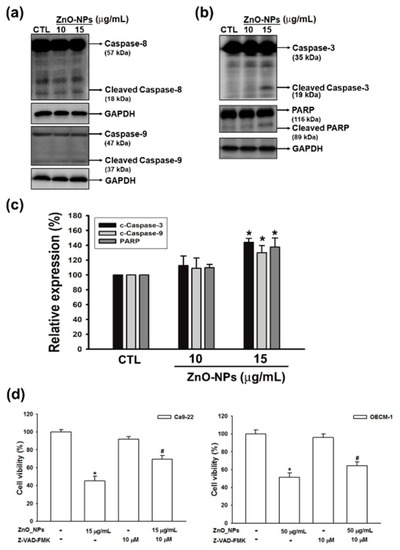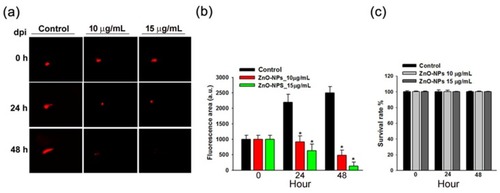- Title
-
ZnO Nanoparticles Induced Caspase-Dependent Apoptosis in Gingival Squamous Cell Carcinoma through Mitochondrial Dysfunction and p70S6K Signaling Pathway
- Authors
- L, S.W., Lee, C.H., Lin, M.S., Chi, C.W., Chen, Y.J., Wang, G.S., Liao, K.W., Chiu, L.P., Wu, S.H., Huang, D.M., Chen, L., Shen, Y.S.
- Source
- Full text @ Int. J. Mol. Sci.
|
Effects of zinc oxide nanoparticles (ZnO-NPs) on cell growth in human gingival squamous cell carcinoma (GSCC) and normal cells. Ca9-22 or OECM-1 cells were incubated with the indicated concentrations of ZnO-NPs for 24 h. The cell morphology ( |
|
Effects of ZnO-NPs on cell cycle progression and apoptosis in human GSCC cells. ( |
|
Effects of ZnO-NPs on the production of reactive oxygen species (ROS) and superoxide in human GSCC cells. ( |
|
Effects of ZnO-NPs on mitochondrial membrane potential of human GSCC cells. ( |
|
Effects of ZnO-NPs on caspase cascade in human GSCC cells. Ca9-22 cells were treated with the indicated concentrations of ZnO-NPs for 24 h. Then, cells were harvested and lysed for the detection of initiator caspase (caspase -8 and -9) ( |
|
Effects of ZnO-NPs on the activation of mTOR and p70S6K in human GSCC cells. ( |
|
Effects of ZnO-NPs on tumor growth of Ca9-22 cells in zebrafish xenograft model. ( |
|
Schematic diagram of ZnO-NP-induced anti-cancer mechanism in human GSCC. Our study data indicate that ZnO-NPs may promote caspase-dependent apoptosis via mechanisms involving both superoxide-mediated mitochondrial intrinsic and p70S6K signaling pathways. |








